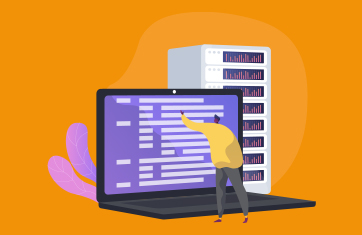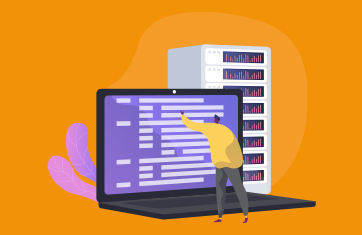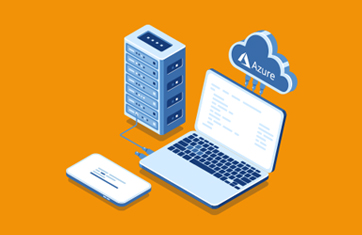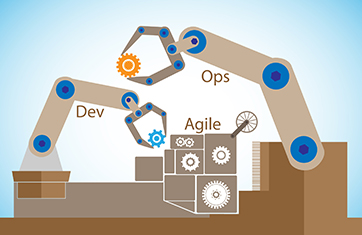Infrastructure as Code
What is Infrastructure as Code (IaC)?
IaC, meaning “infrastructure as code,” involves defining the digital infrastructure you need using code instead of manual setups. Yes, you heard that right; it entails using code, just like what you work with when creating apps. With IaC, you script out the instructions and configurations for your virtual servers, operating systems, and other infrastructure components. You can then take these scripts, or templates, and use them to automatically provision and manage your tech stack. Infrastructure as code allows you to write your network just like you create your applications. Do you need more server space? Just update the code. Do you want to replicate your environment for a new project? Copy your code, and you’ll be ready to launch your new project in no time. IaC turns your IT infrastructure into a repeatable, version-controlled template that is efficient, error-free, and easily shareable. Think of all the time and resources you’ll save with this handy tool.
Benefits of Infrastructure as Code
After exploring the definition of IaC, it is time to dive into some of its benefits, which include:
Infrastructure as code provides many advantages over more traditional manual approaches. As a result, you can improve efficiency, save money, reduce risk, and ensure consistency across your infrastructure.
Infrastructure as Code Tools
To harness the full power of infrastructure as code, you will need the right IaC tools. There are tools for each and every part of the IaC process, including:
Choosing the right mix of tools is critical. Make sure to select complementary IaC tools that work well together so you can maintain a holistic view of your infrastructure code.
What are popular IaC tools?
There are many popular Infrastructure as Code (IaC) tools, some of the widely used ones include:
Choosing the right IaC tool depends on factors such as the specific requirements of the project, the preferred syntax, and the targeted infrastructure platforms. Many organizations use a combination of these tools to meet their diverse needs. We’ve discussed some of these tools in more depth in other articles, please see: Top DevOps Tools | eG Innovations and Azure automation tools | eG Innovations.
IaC, Containers and Kubernetes
Infrastructure as Code (IaC) plays a pivotal role in Kubernetes and containerized architectures, contributing to their ubiquity and success. In these environments, IaC provides a systematic and repeatable approach to defining, provisioning, and configuring infrastructure. This codified representation ensures consistency across development, testing, and production stages. In Kubernetes, IaC defines the desired state of the cluster, including the deployment, services, and configurations, allowing for automated, version-controlled updates.
The synergy between IaC and containers fosters rapid development and deployment cycles, reducing manual errors and enhancing collaboration among development and operations teams. This consistency and automation are critical for managing the dynamic, distributed nature of containerized applications, facilitating scalability and resilience. As a result, IaC has become a cornerstone in the evolution and widespread adoption of Kubernetes and containerized architectures, supporting the principles of DevOps and enabling organizations to harness the full potential of cloud-native technologies.
IaC Best Practices
As with any technology, there is a right way to do IaC, as well as a great many ways to get it wrong. Here are some best practices to help you leverage infrastructure as code to its fullest potential:
When applied diligently, these practices will help you reap the benefits of IaC and maximize business agility.
And remember that embracing IaC allows you to do so much more than just update your technology. It also enables you to optimize how you do business in the digital world. With the right mindset, tools, and practices, IaC can become the cornerstone of your IT strategy.
IaC and Git / GitHub
Version control is essential to Infrastructure as Code (IaC) as it ensures a systematic and organized approach to managing infrastructure changes. With tools like Git, teams can track modifications, collaborate efficiently, and revert to previous configurations if needed. Beyond facilitating collaboration among team members, it is key to a reliable and auditable development process. Version control safeguards against errors, supports parallel development, and is fundamental for maintaining the integrity, consistency, and scalability of IaC projects.
While Git and GitHub are not traditional Infrastructure as Code (IaC) tools, they play a crucial role in the IaC ecosystem by providing version control and collaboration features for managing infrastructure code. Here's how Git and GitHub are often used in conjunction with IaC:
Git:
GitHub:
GitLab and Bitbucket:
It's worth noting that GitLab and Bitbucket are alternative platforms that also offer Git repository hosting and collaboration features similar to GitHub. Many organizations choose one of these platforms based on their specific needs and preferences.
Teams often use Git in conjunction with IaC tools like Terraform, Ansible, or others to ensure effective versioning, collaboration, and traceability in their infrastructure development processes.
IaC and How it Relates to Monitoring Tools
Infrastructure-as-Code (IaC) is becoming universal for defining and automating the creation and deployment of IT infrastructure. Higher-level languages and scripts are used to define the infrastructure that applications run on. These frameworks include networking, servers, data storage, and so on.
This is all taking place as auto-scaling and auto-deployment becomes standard, as well. As a result, IaC may now define how infrastructure should auto-scale up or down to service the needs of applications.
In this type of environment, monitoring and observability tools need to deploy alongside the applications and infrastructure automatically. To learn more about how this can be achieved, please see: How to Monitor IT Infrastructure when adopting IaC for VDI and Digital Workspaces | eG Innovations.






